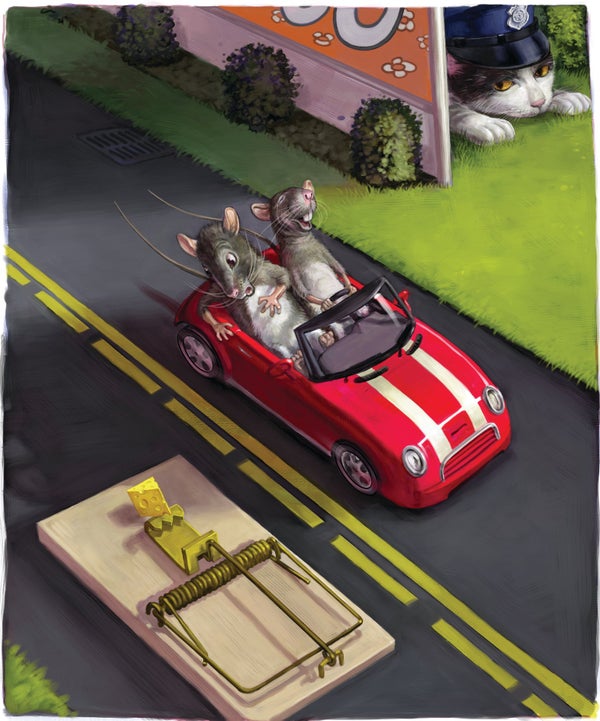One way to kill time in New York City while waiting for a subway train is to look for rats. You can often find one or two down at track level, although I've also seen the occasional Rattus norvegicus up on the platform just standing around with its weary fellow mammalians. One enterprising subway rat went viral in 2015, when it was videoed dragging an entire slice of pizza down a flight of stairs. But when you leave the big city, the major mode of transportation becomes the car. And that's why rats in Richmond, Va., have learned to drive.
Okay, that's not completely accurate—Richmond's mass-transit system is not what forced rodents to get behind the wheel. In fact, their little custom-made cars don't even have steering wheels. But the rats are definitely driving. For science.
Researchers at the University of Richmond built what they called an ROV, which you might assume stands for “Really? Oh, Very” but which is actually an acronym for Rodent-Operated Vehicle. The ROV is fashioned from a one-gallon clear plastic food container, which provides excellent visibility both for and of the driver, and a commercially available robot car kit.
On supporting science journalism
If you're enjoying this article, consider supporting our award-winning journalism by subscribing. By purchasing a subscription you are helping to ensure the future of impactful stories about the discoveries and ideas shaping our world today.
Of course, you can't simply tell a rat to take the ROV out for a spin. So the scientists connected a battery to an aluminum plate on the inside bottom of the cab. They also attached copper wire to the other terminal of the battery and bent that wire to form a series of thin bars placed at the inside front of the cab. When a rat with its rear feet on the plate placed its front feet on the wires, it completed an electrical circuit that powered the car's motor. And Mario Andratti was off.
According to the researchers' article last October online in Behavioural Brain Research, “Driving training began when the animals were approximately 5 months of age.” That might seem young, but male rats reach sexual maturity at six weeks, so their wait for a car must seem endless. By moving their front paws to different positions on the copper wire, the rats quickly learned to steer their really-mini vans. Although rats clearly could acquire the ability to drive, not one could pass the written test. Seems that writing a parking ticket may be harder than parking.
The motivation for the furry chauffeurs was to get a reward much loved by rats and graduate students alike: Froot Loops. The rats got a quarter of a torus of the sugary treat; their driving instructors no doubt threw back a few handfuls when rotating and balancing the tires. Video of the vehicular vermin can be found online, and, frankly, I've seen worse driving in Florida shopping center parking lots.
So why go to all this trouble when rats are happy to run mazes for their cereal? The answer is in the title of the study: “Enriched Environment Exposure Accelerates Rodent Driving Skills.” (The magazine New Scientist had the more pedestrian headline, “Scientists Have Trained Rats to Drive Tiny Cars to Collect Food.” Actually most human driving is also about food collection. Or money-earning. For food collection.)
Some of the rats were reared in “enriched environments” that provided their little brains with stimulation. Others were reared in “standard laboratory housing.” (Still others were rear-ended.) And the rats that grew up in the well-to-do neighborhoods were quicker to learn to drive and maintained the skill longer than did their downbeat comrades.
As the researchers note in their write-up: “The complex driving task was viewed as a model for human-machine interactions such as driving a car or operating other technological devices.” So Dale Earnhrat could serve as a model for research about “learning and skill acquisition.”
Another finding: based on analyses of the ratio of the levels of two hormones, it appears that the rats found driving to be relaxing. Of course, they were in a controlled setting, not trying to go west on 42nd Street at 5 P.M. on a weekday. In that situation, your savvy rat knows that the shuttle train from Grand Central to Times Square takes much less of a toll. Even without traffic, a train-riding rat will probably beat a car-driving rat by a whisker.
